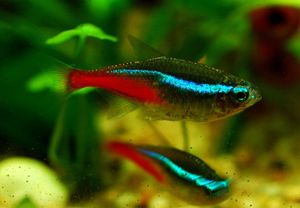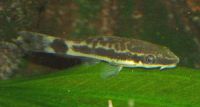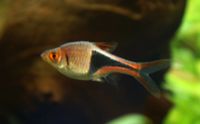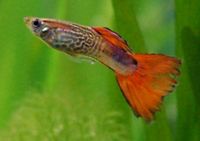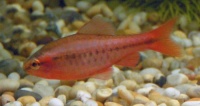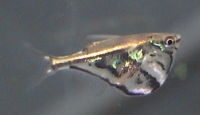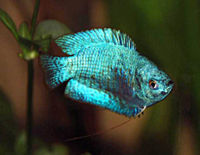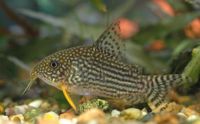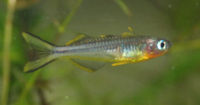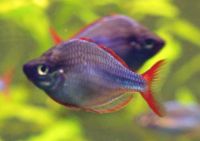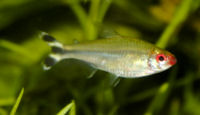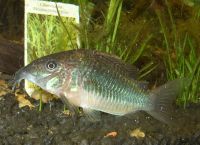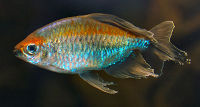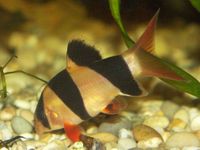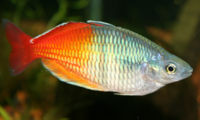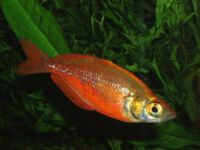Stocking a Peaceful Community Tank
| Remember, none of these fish will be able to go into your tank until it's completed The Nitrogen Cycle! If you are unsure of how to set up your tank read through our Guides. |
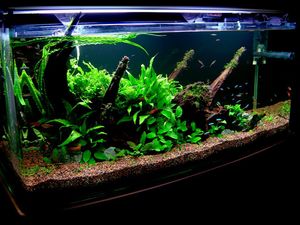
The choices below are arranged by tank size, obviously those listed for the smaller tank would be suitable for the larger tanks and appreciate more space, but not vice versa! All tanks should have completed the nitrogen cycle beforehand and all fish listed are tropical fish so require a heated tank.
The fish listed are considered entirely peaceful. They will not eat or bully tank mates. Some may show a tendency to fin nip however if kept in too small a group or kept with slower fish. It must also be born in mind that larger fish, no matter how peaceful, may still consider much smaller fish as a meal, even if they're known for being vegetarian! Always research fish species extensively before purchase.
Contents
- 1 Under 38 Litres (10 US G.)
- 2 57 Litres (15 US G.) plus
- 2.1 Stocking Suggestions
- 2.2 Compatible Livestock
- 2.2.1 Neon Tetra (Paracheirodon innesi)
- 2.2.2 Glowlight Tetra (Hemigrammus erythrozonus)
- 2.2.3 Green Neon Tetra (Paracheirodon simulans)
- 2.2.4 Cardinal Tetra (Paracheirodon axelrodi)
- 2.2.5 Otocinclus (Otocinclus sp)
- 2.2.6 Pitbull Pleco (Parotocinclus jumbo)
- 2.2.7 Harlequin Rasbora (Trigonostigma heteromorpha)
- 2.2.8 Guppy (Poecilia reticulata)
- 2.2.9 Threadfin Rainbowfish (Iriatherina werneri)
- 2.2.10 Cherry Barb (Puntius titteya)
- 2.2.11 Marbled Hatchetfish (Carnegiella strigata strigata)
- 2.2.12 Dwarf Pencilfish (Nannostomus marginatus)
- 2.2.13 Dwarf Gourami (Colisa lalia)
- 2.2.14 Honey Gourami (Colisa chuna)
- 2.2.15 Bronze Corydora (Corydoras aeneus)
- 2.2.16 Sterbai Cory (Corydoras sterbai)
- 2.2.17 Panda Cory (Corydoras panda)
- 2.2.18 Platy (Xiphophorus maculatus)
- 2.2.19 Forktail Rainbowfish (Pseudomugil furcatus)
- 3 76 Litres (20 US G.) plus
- 4 114 Litres (30 US G.) plus
- 5 208 Litres (55 US G.) plus
Under 38 Litres (10 US G.)
See Stocking a 10 Gallon Tank and Stocking a 5 Gallon Tank.
57 Litres (15 US G.) plus
Stocking Suggestions
In this size tank it's recommended to consider one group of shoaling fish, with a small group of bottom dwellers and one (or a pair) of centrepiece fish. For example:
- 6 Neon Tetras
- Male/Female Dwarf Gourami pair
- 3-4 Panda Corys
Or a variation on that. For a first community tank this would be ideal. Once you become more experienced variations on this can be considered.
Compatible Livestock
Neon Tetra (Paracheirodon innesi)
Neons are peaceful and common shoaling fish. In order to have a healthy group they should be kept in a minimum of 6-8 individuals. Smaller groups will be shy and withdrawn and may turn to nipping at tank mates. In a 57-76 Litres (15-20 US G.) a maximum of 8-10 should be considered. They are mid to top dwelling fish and kept with other peaceful fish will not shoal tightly together and will spread throughout the tank.
Glowlight Tetra (Hemigrammus erythrozonus)
The Glowlight has exactly the same needs as the Neon Tetra, in fact it looks very similar but is minus the bold blue markings and has a red lateral stripe rather than blue. In this size tank a group of 6-10 would be suitable and, like the Neon, will not shoal tightly when it's secure in its own environment.
Green Neon Tetra (Paracheirodon simulans)
The Green Neon Tetra is the opposite of the Glowlight Tetra. It lacks the red horizontal band but has a strong lateral green/blue iridescent band from the nose to the caudal peduncle. Like the Glolights and Neons, they're happiest in groups and otherwise have very similar care needs.
Cardinal Tetra (Paracheirodon axelrodi)
The Cardinal Tetra is like an over-sized Neon Tetra, instead of having the red colouring on only half the body, on the Cardinal it extends from the gill plates to the caudal fin. They are larger than Neons but have the same care needs, to be in a shoal of 6 or more in a laterally spacious tank.
Otocinclus (Otocinclus sp)
Otos (usually Otocinclus macrospilus, Otocinclus mariae or Otocinclus vittatus) are some of the smallest of the Pleco family available in the pet trade. These tiny suckermouth catfish are sociable, and best kept in groups of 3 or more. They are excellent little algae eaters, but will only eat some soft algaes, they will not touch hair algae or tough green spot algae. They benefit from bogwood being present and will need supplementary feeding of sinking algae wafers and blanched vegetables. These little fish are almost always wild caught and can be very delicate, they should only be added to mature tanks at least 6 months old. They often have a fairly poor survival rate in captivity.
Pitbull Pleco (Parotocinclus jumbo)
This is a small and entirely peaceful Pleco that may get mislabelled as Otocinclus. Like Otos, they're happiest in groups and will eat some soft algaes, and also be supplemented with algae wafers and blanched vegetables. Should happily cohabit with other peaceful similar sized fish without any problems. They are at risk of being eaten by larger fish though.
Harlequin Rasbora (Trigonostigma heteromorpha)
With similar shoaling habits to the Neon Tetra, the Harlequin is a popular alternative to Tetras. It is entirely peaceful and best in groups of 6 or more. It is mid-top dwelling and its orange colouration is quite striking against a green planted backdrop.
Guppy (Poecilia reticulata)
A very common and well loved fish. The fancy males, with their long colourful fins, are a popular choice. These are very prolific livebearers and females should be kept with caution, even without males present they can still give birth if they were kept with males at the breeders or at the store. For a worry-free tank, keep males only. In a group of 4-5 plus they should not worry each other. They are active fish and appreciate lateral swimming room, however, the long-tails of fancies mean they cannot be kept in tanks with strong currents.
Threadfin Rainbowfish (Iriatherina werneri)
An interesting alternative to more well known shoaling fish. The Threadfin is very distinctive to look at and entirely peaceful. It's best to keep 1 male to 2-3 females, more than one male to a tank is advisable as this is when they show their best colours as they show off towards each other. They shouldn't fight. Due to their long fins it's best they're not kept with anything that may even slightly nip such as Tetras.
Cherry Barb (Puntius titteya)
The Cherry Barb is one of the more peaceful of the Barb family. Unlike it's notoriously nippy cousin, the Tiger Barb, the Cherry will generally be fairly oblivious to tank mates as long as they're kept in a good group, several females to a male are recommended, a minimum of 6 individuals makes for a good group. They shouldn't be nippy, but do not keep with very long finned fish just in case!
Marbled Hatchetfish (Carnegiella strigata strigata)
This Hatchetfish is entirely top-dwelling, the same as its other Hatchetfish cousins. It is entirely peaceful and must be kept in groups of 6 or more, smaller groups will leave the fish stressed and far more likely to jump. Speaking of jumping, these guys are pros and a tank with Hatchets must have a very secure lid with no holes at all, and be wary when you have the lid open for routine maintenance too! They work well with mid-bottom dwelling fish and should really be kept as the only top-dweller.
Dwarf Pencilfish (Nannostomus marginatus)
The Dwarf Pencilfish is small and peaceful and an interesting alternative to Tetras. It's not strictly shoaling but does better with others of it's own kind, keep in groups of at least 3-4 or more. They are tiny and shouldn't be kept with much larger or boisterous fish.
Dwarf Gourami (Colisa lalia)
A well known Gourami that must be bought with caution. They are known to carry their own virus, the Gourami Iridovirus, any tanks with sick fish should be avoided, and any fish shipped from Asia should definitely be avoided. Apart from that, a male alone, or a male/female pair would be fine in a 57-76 Litres (15-20 US G.). Do not keep two males as they will fight. They are otherwise peaceful fish who occupy the mid-top levels of the tank.
Honey Gourami (Colisa chuna)
The Honey Gourami is a colourful addition to a small community tank. They are generally peaceful, but two males can be aggressive to one another. It's best to keep either a single male, a single female or a male/female pair, in 57-76 Litres (15-20 US G.) you could keep one male and several females. Due to their long ventral fins, they should not be kept with nippy fish and should not be mixed with other Gourami species.
Bronze Corydora (Corydoras aeneus)
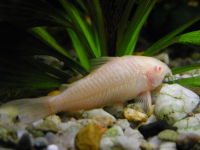
Also commonly seen in albino, this is one of the most well known Corydoras. They get to around 6.4cm (2.5") and in a 57-76 Litres (15-20 US G.) only 3-4 should be kept. They must be kept with others of their own kind however as they love company of their own and will bumble around the bottom of the tank scavenging for food and will not bother tank mates.
Sterbai Cory (Corydoras sterbai)
An attractive spotty Corydora also often seen and a good alternative to the Bronze Corydora. It stays a little smaller than the Bronze at 5.1cm (2") and also must have company of it's own kind, again 3-4 in a 57 Litres (15 US G.), more in larger tanks.
Panda Cory (Corydoras panda)
A popular Cory, with a cream body and dark bands over the eyes, on the dorsal fin and another on the tail. Another good alternative to the Bronze Corydora. It stays a little smaller than the Bronze at 5.1cm (2") much like the Sterbai above, and also must have company of it's own kind, again 3-4 in a 57 Litres (15 US G.), more in larger tanks.
Platy (Xiphophorus maculatus)
Another common and popular livebearer, the Platy is a good colour choice for an aquarium. Selectively bred with many colours now available including orange and blue. Like other livebearers, they are very prolific, to stop overstocking with unwanted fry, keep males only. They should not bother other tank mates.
Forktail Rainbowfish (Pseudomugil furcatus)
An attractive alternative to other small groups of fish. Should be kept in groups of their own kind, 5-6 in a 57 Litres (15 US G.). Males should be kept in similar ratios as with livebearers as males will show some aggression towards one another. Avoid keeping with long-finned fish and slow-moving fish but should be fine with other fish like Tetras.
76 Litres (20 US G.) plus
Stocking Suggestions
This size tank should be stocked carefully also, and always bear dimensions in mind! You can still go with the basic one shoal/some bottom dwellers/centrepiece option though, just a couple more shoalers would work, a stocking example could be:
- 6 Rummynose Tetras
- 5 Kuhli Loachs
- 1 Male Dwarf Gourami
- 2 Female Dwarf Gouramis
Compatible Livestock
Zebra Danio (Brachydanio rerio)
Zebra Danios (and their cousins the Leopard Danio) are often marketed for much smaller tanks, these very active fish really need as much lateral swimming space as possible. They should be kept in groups of 6 or more, smaller groups may result in them turning to fin nipping and bothering tank mates. They are mid-top dwelling and shouldn't be kept with slower moving mid-top dwellers like Gouramis as their active nature could be bothersome. Zebras are ideal for a highly-active community.
Dwarf Neon Rainbowfish (Melanotaenia praecox)
An active mid-swimming peaceful shoaling fish. Keep this Rainbowfish in groups, more females than males. They should not bother tank mates, but do not keep with very long-finned fish. They are otherwise entirely peaceful and a good alternative to Tetras and Rasboras. Do well in planted tanks.
Rummynose Tetra (Hemigrammus rhodostomus)
A larger Tetra that must be in groups of 5-6 or more. Will mostly occupy the mid-bottom levels of the tank and can be sensitive to water quality, so regular water changes and mature tanks are a must. An otherwise peaceful active fish provided it's kept in a good shoal.
Kuhli Loach (Pangio kuhlii)
An unusual and popular eel-like fish, the Kuhli Loach is entirely bottom dwelling and requires a soft sand or small soft gravel substrate in which to burrow. They must be in groups of 4-5 or more, otherwise they'll be so shy they'll never be seen. They are oblivious to tank mates and due to their slender size to not offer much in the way of mess in terms of bioload. Can uproot live plants.
Bristlenose Pleco (Ancistrus sp)
One of the most common of the small Pleco species. The Bristlenose comes in either mottled spotted brown, or there are albino variations also. They are peaceful, should keep to themselves, and can be kept in male/female pairs, and will breed readily in captivity too. They need a nice cave or two to call their own. They are so called as they will develop bristles all over their snout and head.
114 Litres (30 US G.) plus
Compatible Livestock
Upside-Down Catfish (Synodontis nigriventris)
This is one of the smaller and most well known Synodontis. It is an active mid-bottom dweller that will characteristically swim entirely upside down. They are sociable fish and must be kept in groups of 4-5 or more, in smaller groups they may be nippy and one will become dominant. They should not be kept with smaller fish but will be peaceful towards other larger peaceful community fish. They are active swimmers that require plenty of space as well as hiding places.
Emerald Catfish (Brochis splendens)
The Brochis Catfish looks like a giant Bronze Cory. They get to around 10.2cm (4") (sometimes a little larger), and like the Bronze Cory are happiest in schools of their own kind. They will not bother any tank mates and keep to themselves. Due to their larger size, they do better in larger tanks than the Bronze Cory.
Congo Tetra (Phenacogrammus interruptus)
An attractive and popular larger Tetra, the Congo does well in a group of at least 5 or more. They are very pretty fish with long flowing tails which rules them out from being kept with anything that may fin nip. They are mid-top dwelling active fish that do well in a long tank with a good mix of open swimming space and hiding places in tall plants.
Glass Catfish (Kryptopterus bicirrhis or Kryptopterus vitreolus)
An interesting fish with an entirely transparent body. This catfish gets approximately 5.1-7.6cm (2-3") (K.vitreolus) or 12.7-15.2cm (5-6") (K.bicirrhis) in length so requires a spacious tank. They can be pretty shy so must be in groups of at least 4-5 or more. They should cohabit peacefully with similar sized peaceful fish, but will be bullied by more boisterous fish. Does not cope in strong currents or very bright lighting, does best in densely planted mature tanks.
African Glass Catfish (Pareutropius buffei)
A peaceful and shy fish with very similar needs to the Glass Catfish above. This fish must be kept in groups of at least 5-6, they do not do well alone at all, and must have some shelter such as dense planting and caves in which to dart into if startled. They also won't be happy with very bright lighting. They get to around 7.6cm (3") and are quite distinctive little fish, generally keeping to the mid-bottom levels of the tank but not sitting on the substrate.
208 Litres (55 US G.) plus
Compatible Livestock
Clown Loach (Chromobotia macracanthus)
These are popular large bottom-dwelling fish. They are very large growing, at around 30.5cm (12") and a final tank size of over 379 Litres (100 US G.) should be considered. Despite their large size, they grow slowly, it will take several years for them to reach their full potential, so can be kept in smaller housing of around 208 Litres (55 US G.), but this should only be temporary. Like most common Loaches, they are very sociable and must be kept in groups of at least 3-4 or more. They are bottom dwelling and ideally should be the only bottom-dwellers. They may eat small fry but are otherwise oblivious to tank mates as long as they have company of their own kind.
Boesemani Rainbowfish (Melanotaenia boesemani)
A very colourful larger Rainbowfish. These are sociable fish and are best in groups, with more females per males, but keeping several males will result in the best colour displays. They shouldn't be kept with much smaller fish nor with very long-finned fish. They are active mid-swimming fish that do well in planted tanks with open swimming space.
Red Rainbowfish (Glossolepis incisus)
Another large growing Rainbowfish. The Red Rainbowfish is exactly that, it is a vibrant bright red all over and adults are surprisingly chunky fish too. They are sociable and like other Rainbows are best kept in groups with more females than males, the males will display to one another. They are peaceful but are very active fish, so do not keep with shy slow swimming fish as they may get scared into the shadows with these fish buzzing around the tank. Their bright colour looks fantastic against a green planted backdrop.
Common Pleco (Hypostomus plecostomus)
The Common Pleco is technically a common name for several very similar looking species, only an experienced eye can differentiate them. This fish is often sold as a "cleaner" for smaller tanks, trouble is it grows over 30.5cm (12") and is therefore only suitable for very well filtered larger tanks. They are generally oblivious to tank mates and will busy themselves grazing on bogwood. They are, however, territorial towards other Plecos so only one Pleco to a tank! They should be supplemented with blanched vegetables and sinking algae wafers, they may also nibble on other meaty foods like bloodworm that's been put in for tank mates. Do not keep with very small fish or fish that may fin nip. They are primarily nocturnal so need plenty of gloomy hiding places and will be most active and be more likely to feed at night. Planted tanks don't do well with Plecos, they will uproot delicate plants.
Gold Spot Pleco (Pterygoplichthys joselimaianus)
The Gold Spot, or L001, is often miss-sold under the name "Common Pleco". This fish will get around 25.4-30.5cm (10-12") and be messy so, like the Common Pleco above, needs space and an excellent filter system! Can be territorial towards other Pleco species also. Will uproot and dislodge plants and precarious decorations.
Sailfin Pleco (Glyptoperichthys gibbiceps)
The Sailfin Pleco is another very large growing but commonly sold Pleco. It can get around 45.7-61cm (18-24") so needs a very large and very very well filtered tank with some equally sized hiding places. They usually just keep to themselves though and won't bother tank mates, not often a fan of their own species however. They should be supplemented with blanched vegetables and sinking algae wafers, they may also nibble on other meaty foods like bloodworm that's been put in for tank mates. Do not keep with very small fish or fish that may fin nip. They are primarily nocturnal so need plenty of gloomy hiding places and will be most active and be more likely to feed at night. Planted tanks don't do well with Plecos, they will uproot delicate plants.
